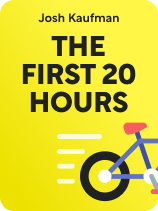

This article is an excerpt from the Shortform book guide to "The First 20 Hours" by Josh Kaufman. Shortform has the world's best summaries and analyses of books you should be reading.
Like this article? Sign up for a free trial here.
If you want to learn a new skill, should you just dive in? How can you maximize your chances for success and keep from squandering resources?
Once you’ve chosen a new skill to learn, Josh Kaufman suggests you conduct research to learn about the skill and prepare what you need to practice it. Acquiring knowledge and information about the skill beforehand allows you to practice smarter and avoid wasting time and energy on ineffective techniques.
Read on for Kaufman’s advice on how to prepare to learn a new skill before you start practicing.
Prepare to Learn a New Skill
Kaufman recommends that you prepare to learn a new skill by doing some research before going hands-on. Research just enough that you’ll be able to recognize and fix mistakes when practicing. Kaufman stresses that research and learning aren’t the same as practicing, so don’t spend too long on this step, as you’ll acquire a skill more quickly by practicing it than studying it endlessly.
(Shortform note: In Ultralearning, Scott Young refers to researching the skill you want to learn as metalearning and argues that it’s crucial for self-directed learning. Without proper research and preparation, you risk following a poor learning approach. However, to avoid spending too much time researching, Young suggests you estimate how long you plan to spend learning your skill and allot 10% of that time for research. For example, if you want to learn your skill in 20 hours, you might plan to spend about two hours researching.)
Kaufman provides some suggestions for researching your skill.
Tip #1: Find Reference Materials
First, gather at least three resources (articles, books, and videos) that discuss the skill and quickly scan through them to find out what you need to know to practice. Look for approaches, techniques, and materials that the different resources agree on. For example, multiple art sources might recommend you learn form by drawing figures like spheres, cubes, and cylinders.
(Shortform note: In A Mind For Numbers, Barbara Oakley explains why skimming is advantageous for learning: It prepares your mind to organize the new information—similar to creating a mental filing cabinet. She explains that you can absorb information better when you already have the categories in mind. This is an example of top-down learning, where you start with the big picture and then add in the details. This contrasts with the bottom-up approach, where you start with the details and then build up to the bigger picture.)
As you research your skill, you’ll likely encounter terms or concepts that are unfamiliar to you. Kaufman assures that confusion is not only normal at this point but encouraged. The more confused you are, the more motivated you’ll be to learn and the faster you’ll progress.
(Shortform note: Some research suggests that confusion actually enhances your learning by making you think more deeply and remember more information in the long run. However, experts point out that confusion is only beneficial if you have the resources or guidance to resolve it. If you don’t, you may feel stuck and give up on your skill. This underscores the value of Kaufman’s suggestion to gather and skim resources before you start practicing, so you have everything you need to cope with confusion and learn more effectively.)
Tip #2: Look for Mental Models
To make the most of the information you find during your research, Kaufman recommends you look for mental models. These are concepts you learn that help you understand how something works. For instance, in creative storytelling, the Hero’s Journey (which describes a common 12-stage story structure) is a mental model for understanding how to structure a plot.
(Shortform note: You can use mental models not only for understanding specific skills and disciplines, but also for general thinking and decision-making in all areas of your life. Just as each skill has its own concepts, Shane Parrish and Rhiannon Beaubien write that the world functions according to a set of concepts and rules that can be simplified with mental models. In The Great Mental Models Volume 1, they present nine mental models to improve your thinking and decision-making. Learning different kinds of mental models (both skill-specific and broadly applicable) can help you enhance both your skill learning ability and understanding of the world.)
To remember the mental models you come across, use metaphors or analogies to connect them with things you already know and understand. For example, you can think of books or films that follow the Hero’s Journey structure. Drawing on these connections helps you to apply new knowledge more easily when you’re putting the skill to practice.
(Shortform note: In Learning How to Learn, Barbara Oakley and Terrence Sejnowski suggest ways for making your metaphors more memorable. One way is to create mental pictures that allow you to visualize the metaphor. Pictures are easier to commit to memory than abstract concepts. Another way is to create acronyms or mnemonics—for example, if you’re trying to remember the notes of the treble clef (E-G-B-D-F), you might create a memorable mnemonic like “Energetic grasshoppers buy donuts frequently.”)
Tip #3: Consult Experts
Another way Kaufman suggests you research your skill is to ask experts for advice. Experts can clear up misconceptions you have about learning the skill and help you set realistic expectations for yourself. They may also have tips that can help you avoid wasting time, money, and energy on unnecessary supplies or ineffective techniques.
(Shortform note: If you can’t connect with any experts in your skill, psychologist Anders Ericsson says in Peak that you can still gain helpful insights by investigating the methods they used to achieve their level of performance. For example, if you want to learn digital art, research the training methods of professional digital artists and imitate their process. Ericsson recommends that when you do so, you focus on what they’re doing differently from others and try to replicate that.)
Tip #4: Gather Necessary Materials
In addition to learning about your skill, you’ll also need to gather the right tools and equipment to practice the skill. Based on your research, identify everything you’ll need and make sure you can acquire it—whether it’s a piece of equipment, software, or facility. This way, you won’t disrupt your practice by suddenly discovering that you’re missing a vital component.
(Shortform note: While the equipment that’s required for some skills can be expensive, don’t be discouraged if you’re on a tight budget. If you can’t buy all the necessary materials, get creative and find alternative ways to get what you need. For example, you could borrow equipment from a friend, or you could organize a community swap where you exchange items with others. Another option is to use the Internet—there are many websites that help you learn skills for free.)
Tip #5: Identify Essential Subskills
The next step is to separate the skill into subskills and focus on learning the most essential ones. Kaufman explains that most skills are composed of a set of smaller skills. These subskills should include everything you need to attain your proficiency goal (and you’ll likely have found some important ones during your research). For example, if you want to learn to skateboard for commuting purposes, you’ll need to learn several subskills, such as how to balance, push, and turn your board.
(Shortform note: In The Art of Learning, Josh Waitzkin echoes Kaufman’s advice to break down your skill and suggests you patiently learn the fundamentals. He argues that the fundamentals are the most important elements of a skill, so you should learn them first. Once you’ve defined the basic elements, practice each in isolation until they become intuitive. This has two benefits: First, when you have a solid grasp of the basics, you’ll be able to combine and use them in new ways and in different situations. Second, by diligently working at the basics, you learn to appreciate the process of learning and growing over the outcome.)
To make sure you’ve identified all crucial subskills, Kaufman suggests you think of the worst-case scenario that can occur when you’re practicing the skill. Think about what’s risky or what outcomes you want to avoid. For example, when you’re skateboarding, there’s a danger you’ll fall or crash into obstacles. This clues us in to some other vital subskills: How to brake with your foot and how to fall properly.
(Shortform note: People often avoid thinking about the possibility of negative outcomes. That’s why analyzing the worst-case scenario (a mental model called inversion) is a powerful thinking tool: It helps you see things from a different angle. Similarly, some thinkers recommend another counterintuitive way to shift your perspective—by contemplating your mortality. In The Laws of Human Nature, Robert Greene writes that this helps you gain a fresh perspective on your life, clarify what matters most to you, and get motivated to take action. Overall, these two thought exercises share an underlying purpose: To help you consider different viewpoints to make better decisions, anticipate challenges, and achieve your goals.)

———End of Preview———
Like what you just read? Read the rest of the world's best book summary and analysis of Josh Kaufman's "The First 20 Hours" at Shortform.
Here's what you'll find in our full The First 20 Hours summary:
- A simple and effective method for learning almost any skill in 20 hours
- The misconceptions that hold us back from learning new skills
- Actionable tips to help you optimize your skill-building experience






